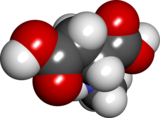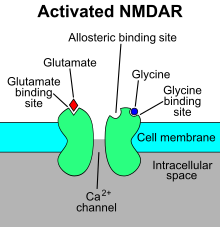N-Methyl-D-aspartic acid
This article needs additional citations for verification. (March 2021) |

| |

| |

| |
| Names | |
|---|---|
| IUPAC name
N-Methyl-D-aspartic acid
| |
| Systematic IUPAC name
(2R)-2-(Methylamino)butanedioic acid[1] | |
| Other names
N-Methylaspartate; N-Methyl-D-aspartate; NMDA
| |
| Identifiers | |
3D model (
JSmol ) |
|
| 1724431 | |
| ChEBI | |
| ChEMBL | |
| ChemSpider | |
IUPHAR/BPS |
|
| KEGG | |
| MeSH | N-Methylaspartate |
PubChem CID
|
|
RTECS number
|
|
| UNII | |
CompTox Dashboard (EPA)
|
|
| |
| |
| Properties | |
| C5H9NO4 | |
| Molar mass | 147.130 g·mol−1 |
| Appearance | White, opaque crystals |
| Odor | Odorless |
| Melting point | 189 to 190 °C (372 to 374 °F; 462 to 463 K) |
| log P | 1.39 |
| Acidity (pKa) | 2.206 |
| Basicity (pKb) | 11.791 |
| Hazards | |
| Lethal dose or concentration (LD, LC): | |
LD50 (median dose)
|
137 mg kg−1 (intraperitoneal, mouse) |
| Related compounds | |
Related amino acid derivatives
|
|
Related compounds
|
Dimethylacetamide |
Except where otherwise noted, data are given for materials in their standard state (at 25 °C [77 °F], 100 kPa).
| |
N-methyl-D-aspartic acid or N-methyl-D-aspartate (NMDA) is an
Biological function
In 1962, J.C. Watkins reported synthesizing NMDA, an
The mechanism of action for the NMDA receptor is a specific agonist binding to its NR2 subunits, and then a non-specific cation channel is opened, which can allow the passage of Ca2+ and Na+ into the cell and K+ out of the cell. Therefore, NMDA receptors will only open if glutamate is in the synapse and concurrently the postsynaptic membrane is already depolarized - acting as coincidence detectors at the neuronal level.[8] The excitatory postsynaptic potential (EPSP) produced by activation of an NMDA receptor also increases the concentration of Ca2+ in the cell. The Ca2+ can in turn function as a second messenger in various signaling pathways.[9][10][11][12] This process is modulated by a number of endogenous and exogenous compounds and plays a key role in a wide range of physiological (such as memory) and pathological processes (such as excitotoxicity).

Antagonists
Examples of
See also
- Anti-NMDA-receptor encephalitis
References
- ^ "N-Methylaspartate - Compound Summary". PubChem Compound. USA: National Center for Biotechnology Information. 24 June 2005. Identification. Retrieved 9 January 2012.
- PMID 14056452.
- S2CID 37212083.
- PMID 10379655.
- PMID 12234462.
- PMID 12234462. Retrieved 2020-05-02.
- S2CID 23002111.
- PMID 27004236.
- PMID 10049997.
- PMID 11775847.
- S2CID 11929361.
- PMID 17088105.
- S2CID 28550919.
Further reading
- Watkins, Jeffrey C.; Jane, David E. (2006), "The glutamate story", Br. J. Pharmacol., 147 (Suppl. 1): S100–S108, PMID 16402093
- Blaise, Mathias-Costa; Sowdhamini, Ramanathan; Rao, Metpally Raghu Prasad; Pradhan, Nithyananda (2004), "Evolutionary trace analysis of ionotropic glutamate receptor sequences and modeling the interactions of agonists with different NMDA receptor subunits", J. Mol. Model., 10 (5–6): 305–316, S2CID 19993673
